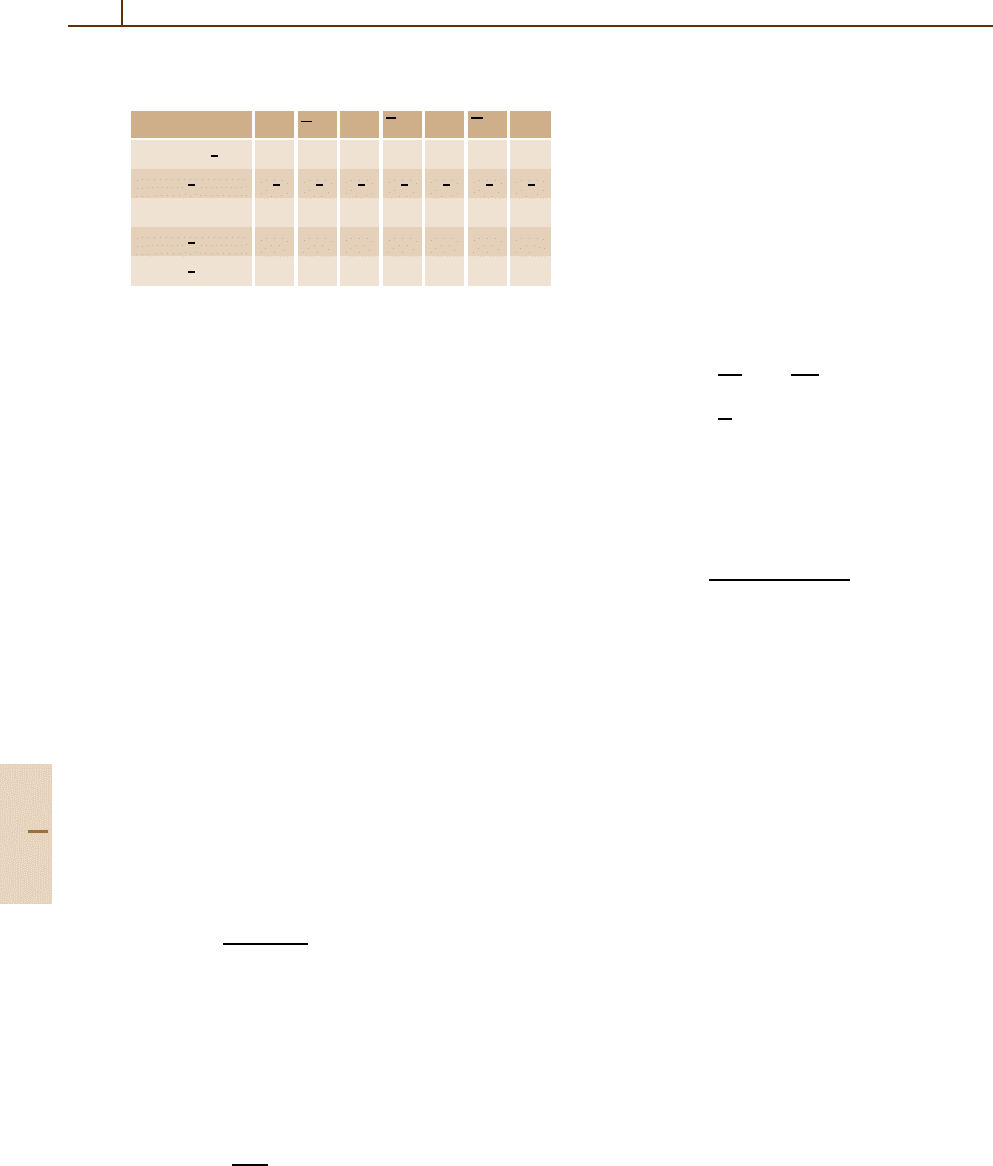Drake G.W.F. (editor) Handbook of Atomic, Molecular, and Optical Physics
Подождите немного. Документ загружается.


Relativistic Atomic Structure 22.5 Spherical Symmetry 337
and inserting into (22.85), resulting in a hierarchy of
equations
Ω
(1)
, H
0
P = (V − PV )P = QVP ,
Ω
(2)
, H
0
P =
QVΩ
(1)
−Ω
(1)
PV
P ,
and so on, with H
(n)
eff
= PVΩ
(n−1)
.
22.4.5 Perturbation Theory: Algorithms
The techniques of QED perturbation theory of
Sect. 22.3.4 can be utilized to give computable expres-
sions for perturbation calculations order by order. They
exploit the second quantized representation of opera-
tors of Sect. 22.4.1 along with the use of diagrams to
express the contributions to the wave operator and the
energy as sums over virtual states. The use of Wick’s
theorem to reduce products of normally-ordered opera-
tors, and the linked-diagram or linked-cluster theorem
are explained in Lindgren’s article [22.17]andChapt.5.
Further references and discussion of features which
can exploit vector-processing and parallel-processing
computer architectures may be found in [22.18].
The theory can also be recast so as to sum certain
classes of terms to completion. This depends on the
possibility of expressing the wave operator as a normally
ordered exponential operator
Ω ={exp S}=1 +{S}+
1
2!
{S
2
}+··· ,
where the normally ordered operator S is known as the
cluster operator. Expanding S order by order leads to the
coupled cluster expansion (see also Chapts. 5 and 27).
22.5 Spherical Symmetry
A popular starting point for most calculations in atomic
and molecular structure is the independent particle cen-
tral field approximation. This assumes that the electrons
move independently in a potential field of the form
A
0
(x) =
1
c
φ(r), r =|x|;
A
i
(x) = 0 , i = 1, 2, 3 . (22.86)
Clearly φ(r) is left unchanged by any rotation about the
origin, r = 0, but transforms as the component A
0
(x)
of a 4-vector under other types of Lorentz and Poincaré
transformation such as boosts or translations. However,
solutions in central potentials of this form have a simple
form which is convenient for further calculation.
With this restriction on the 4-potential, Dirac’s
Hamiltonian becomes
ˆ
h
D
=
cα · p+eφ(r) +βm
e
c
2
.
(22.87)
Consider stationary solutions with energy E satisfying
ˆ
h
D
ψ
E
(x) = Eψ
E
(x).
Since
ˆ
h
D
is invariant with respect to rotation about
r = 0, it commutes with the generators J
1
, J
2
, J
3
men-
tioned in Sect. 22.1.1, corresponding to components of
the total angular momentum j of the electron, usually
decomposed into an orbital part l and a spin part s,
j = l+s
(22.88)
where
l
j
= i
jkl
x
k
∂
l
, j = 1, 2, 3
s
j
=
1
2
jkl
σ
kl
, j = 1, 2, 3 .
22.5.1 Eigenstates of Angular Momentum
We can construct simultaneous eigenstates of the op-
erators j
2
and j
3
by using the product representation
D
(l)
× D
(1/2)
of the rotation group SO(3), which is
reducible to the Clebsch–Gordan sum of two irreps
D
(l+1/2)
⊕D
(l−1/2)
. (22.89)
We construct a basis for each irrep from products of ba-
sisvectorsforD
(1/2)
and D
(l)
respectively. D
(1/2)
is
a 2-dimensional representation spanned by the simulta-
neous eigenstates φ
σ
of s
2
and s
3
s
2
φ
σ
=
3
4
φ
σ
, s
3
φ
σ
= σφ
σ
,σ=±
1
2
,
for which we can use 2-rowed vectors
φ
1/2
=
1
0
,φ
−1/2
=
0
1
.
The representation D
(l)
is (2l +1)-dimensional; its basis
vectors can be taken to be the spherical harmonics
Y
m
l
(θ, ϕ) |m =−l, −l +1,... ,l
,
Part B 22.5

338 Part B Atoms
so that
l
2
Y
m
l
(θ, ϕ) = l(l +1)
2
Y
m
l
(θ, ϕ) ,
l
3
Y
m
l
(θ, ϕ) = m Y
m
l
(θ, ϕ) .
We shall assume that spherical harmonics satisfy the
standard relations
l
±
Y
m
l
(θ, ϕ) =[l(l+1)−m(m ±1)]
1/2
Y
m±1
l
(θ, ϕ) ,
where l
±
=l
1
±l
2
,sothat
Y
m
l
(θ, ϕ) =
2l +1
4π
1/2
C
m
l
(θ, ϕ) ,
C
m
l
(θ, ϕ) = (−1)
m
(l −m)!
(l +m)!
1/2
P
m
l
(θ) e
imϕ
,
if m ≥0 ,
C
−m
l
(θ, ϕ) = (−1)
m
C
m
l
(θ, ϕ)
∗
. (22.90)
Basis functions for the representations D
j
with
j = l ±
1
2
have the form (The order of coupling is sig-
nificant, and great confusion results from a mixing
of conventions. Here we couple in the order l, s, j.
The same spin-angle functions are obtained if we
use the order s, l, j but there is a phase difference
(−1)
l−j+1/2
= (−1)
(1−a)/2
. You have been warned!)
χ
j,m,a
(θ, ϕ)
=
σ
"
l, m −σ,
1
2
,σ
l,
1
2
, j, m
#
Y
m−σ
l
(θ, ϕ)φ
σ
(22.91)
where l, m −σ,
1
2
,σ|l,
1
2
, j, m is a Clebsch–Gordan
coefficient with
l = j −
1
2
a, a =±1,
m =−j, −j +1,... , j −1, j .
Inserting explicit expressions for the Clebsch–Gordan
coefficients gives
χ
j,m,−1
(θ, ϕ) =
−
$
j+1−m
2 j+2
%
1/2
Y
m−1/2
j+1/2
(θ, ϕ)
$
j+1+m
2 j+2
%
1/2
Y
m+1/2
j+1/2
(θ, ϕ)
,
χ
j,m,1
(θ, ϕ) =
$
j+m
2 j
%
1/2
Y
m−1/2
j−1/2
(θ, ϕ)
$
j−m
2 j
%
1/2
Y
m+1/2
j−1/2
(θ, ϕ)
.
(22.92)
The vectors (22.92) satisfy
j
2
χ
j,m,a
= j( j +1)χ
j,m,a
, s
2
χ
j,m,a
=
3
4
χ
j,m,a
,
l
2
χ
j,m,a
=l(l +1)χ
j,m,a
, l = j −
1
2
a, a =±1 .
(22.93)
The parity of the angular part is given by (−1)
l
, with the
two possibilities distinguished by means of the operator
K
=−( j
2
−l
2
−s
2
+1) =−(2s· l +1) (22.94)
so that
K
χ
j,m,a
=k
χ
j,m,a
, k
=−
j +
1
2
a, a =±1 .
The basis vectors are orthonormal on the unit sphere
with respect to the inner product
(χ
j
,m
,a
|χ
jma
)
=
χ
†
j
,m
,a
(θ, ϕ)χ
j,m,a
(θ, ϕ) sin θ dθ dϕ
= δ
j
, j
δ
m
,m
δ
a
,a
. (22.95)
22.5.2 Eigenstates of Dirac Hamiltonian
in Spherical Coordinates
Eigenstates of Dirac’s Hamiltonian (22.87) in spheri-
cal coordinates with a spherically symmetric potential
V(r) = eφ(r),
ˆ
h
D
ψ
E
(r) = Eψ
E
(r), (22.96)
are also simultaneous eigenstates of j
2
,of j
3
and of the
operator
K =
K
0
0 −K
,
(22.97)
where K
is defined in (22.94) above. Denote the cor-
responding eigenvalues by j, m and κ,where
κ =±
j +
1
2
.
(22.98)
Then the simultaneous eigenstates take the form
ψ
Eκm
(r) =
1
r
P
Eκ
(r)χ
κ,m
(θ, ϕ)
iQ
Eκ
(r)χ
−κ,m
(θ, ϕ)
,
(22.99)
where κ =−( j +1/2)a is the eigenvalue of K
,andthe
notation χ
κ,m
replaces the notation χ
j,m,a
used previ-
ously in (22.91). The factor i in the lower component
Part B 22.5

Relativistic Atomic Structure 22.5 Spherical Symmetry 339
ensures that, at least for bound states, the radial am-
plitudes P
Eκ
(r), Q
Eκ
(r) can be chosen to be real. This
decomposition into radial and angular factors exploits
the identity
σ · p
F(r)
r
χ
κ,m
(θ, ϕ)
= i
1
r
dF
dr
+
κF
r
χ
−κ,m
(θ, ϕ) (22.100)
and gives a reduced eigenvalue equation
mc
2
− E +V −c
$
d
dr
−
κ
r
%
c
$
d
dr
+
κ
r
%
−mc
2
− E +V
P
Eκ
(r)
Q
Eκ
(r)
= 0 .
(22.101)
Angular Density Distributions
It is a remarkable fact that the angular density distribu-
tion
A
κ,m
(θ, ϕ) = χ
κ,m
(θ, ϕ)
†
χ
κ,m
(θ, ϕ) , (22.102)
where m =−j, −j +1,... , j −1, j,isindependent of
the sign of κ; the equivalence of
A
j+1/2,m
(θ, ϕ) =
1
4π
( j −m)!
( j +m)!
×
( j −m +1)
2
P
m−1/2
j+1/2
(µ)
2
+
P
m+1/2
j+1/2
(µ)
2
,
and
A
−( j+1/2),m
(θ, ϕ) =
1
4π
( j −m)!
( j +m)!
×
( j +m)
2
P
m−1/2
j−1/2
(µ)
2
+
P
m+1/2
j−1/2
(µ)
2
,
where µ =cos θ, was demonstrated by Hartree [22.19].
Angular densities for the lowest |κ| values are given
in Table 22.1. The corresponding nonrelativistic angular
densities
A
l,m
(θ, ϕ)
nr
=
Y
m
l
(θ, ϕ)
2
=
2l +1
4π
(l −m)!
(l +m)!
P
|m|
l
(µ)
2
;
are listed in Table 22.2.
Radial Density Distributions
The probability density distribution ρ
Eκm
(r) associated
with the stationary state (22.99)isgivenby
ρ
E,κ,m
(r) =
1
r
2
|P
E,κ
(r)|
2
A
κ,m
(θ, ϕ)
+|Q
E,κ
(r)|
2
A
−κ,m
(θ, ϕ)
. (22.103)
Table 22.1 Relativistic angular density functions
|κ| |m| 4π A
|κ|,m
(θ,ϕ)
1
1
2
1
2
3
2
3
2
sin
2
θ
1
2
1
2
(1 +3cos
2
θ)
3
5
2
15
8
sin
4
θ
3
2
3
8
sin
2
θ(1 +15 cos
2
θ)
1
2
3
4
(3cos
2
θ −1)
2
+3sin
2
θ cos
2
θ
Table 22.2 Nonrelativistic angular density functions
l |m| 4π A
l,m
(θ,ϕ)
nr
0 0 1
1 1
3
2
sin
2
θ
0 3cos
2
θ
2 2
15
8
sin
4
θ
1
15
2
sin
2
θ cos
2
θ
0
5
4
(3cos
2
θ −1)
2
Since A
κ,m
does not depend on the sign of κ, the angular
part can be factored so that
ρ
E,κ,m
(r) =
D
E,κ
(r)
r
2
A
|κ|,m
(θ, ϕ) ,
where
D
E,κ
(r) =
|P
E,κ
(r)|
2
+|Q
E,κ
(r)|
2
(22.104)
defines the radial density distribution.
Subshells in j–j Coupling
The notion of a subshell depends on the observation that
the set {ψ
E,κ,m
, m =−j,... , j} haveacommonradial
density distribution. The simplest atomic model is one
in which the electrons move independently in a mean
field central potential. Since
j
m=−j
ρ
E,κ,m
(r) =
2 j +1
4π
D
E,κ
(r)
r
2
, (22.105)
a state of 2 j +1 independent electrons, with one in
each member of the set {ψ
E,κ,m
, m =−j,... , j},has
a spherically symmetric probability density. If E be-
longs to the point spectrum of the Hamiltonian, then
(22.105) gives a distribution localized in r,andwere-
fer to the states {E,κ,m}, m =−j,... , j as belonging
to the subshell {E,κ}.
The notations in use for Dirac central field states
are set out in Table 22.3.Herel is associated with the
orbital angular quantum number of the upper pair of
Part B 22.5

340 Part B Atoms
Table 22.3 Spectroscopic labels and angular quantum num-
bers
Label: s p p d d f f
κ =−
j +
1
2
a
−1 +1 −2 +2 −3 +3 −4
j = l +
1
2
a
1
2
1
2
3
2
3
2
5
2
5
2
7
2
a 1 −1 1 −1 1 −1 1
l = j −
1
2
a 0 1 1 2 2 3 3
¯
l = j +
1
2
a 1 0 2 1 3 2 4
components and
¯
l with the lower pair. Note the useful
equivalence
κ(κ +1) =l(l +1).
Defining
¯
κ := −κ we have also
¯
κ(
¯
κ +1) =
¯
l(
¯
l +1).
22.5.3 Radial Amplitudes
Textbooks on quantum electrodynamics usually contain
extensive discussions of the formalism associated with
the Dirac equation but rarely go beyond the treatment of
the hydrogen atom Chapt. 10. Greiner’s textbook [22.4]
is an honorable exception, with many worked exam-
ples. A more exhaustive list of problems in which exact
solutions are known is contained in [22.20]; it is par-
ticularly rich in detail about equations of motion and
Green’s functions in external electromagnetic fields of
various configurations; coherent states of relativistic par-
ticles; charged particles in quantized plane wave fields. It
also incorporates discussion of extensions of the Dirac
equations due to Pauli which include explicit interac-
tion terms arising from anomalous magnetic or electric
moments.
Atoms and molecules with more than one electron
are not soluble analytically so that numerical models
are needed to make predictions. The solutions are sen-
sitive to boundary conditions on which we focus in this
section. For large r, solutions of (22.101) can be found
proportional to exp(±λr),where
λ =+
&
c
2
− E
2
/c
2
. (22.106)
Thus λ is real when −c
2
≤ E ≤ c
2
,andpure imaginary
otherwise.
Singular Point at r = 0
Singularities of the nuclear potential near r = 0have
a major influence on the nature of solutions of the Dirac
equation. Suppose that the potential has the form
V(r) =−
Z(r)
r
,
(22.107)
so that Z(r) is the effective charge seen by an electron
at radius r from the nuclear center. The dependence of
Z(r) on r may reflect the finite size of the nuclear char ge
distribution, so far treated as a point, or the screening due
to the environment. Assume that Z(r) can be expanded
in a power series of the form
Z(r) = Z
0
+ Z
1
r +Z
2
r
2
+··· (22.108)
in a neighborhood of r = 0. This property characterizes
a number of well-used models
1. Point nucleus: Z
0
= 0; Z
n
= 0, n > 0.
2. Uniform nuclear charge distribution:
V(r) =
−
3Z
2a
1 −
r
2
3a
2
, 0 ≤ r ≤ a ,
−
Z
r
, r > a .
(22.109)
This gives the expansion Z
0
=−3Z/2a, Z
1
= 0,
Z
2
=+Z/2a
3
, Z
n
= 0forn > 2whenr ≤ a.
3. Fermi distribution: The nuclear charge density has
the form
ρ
nuc
(r) =
ρ
0
1 +exp[(r −a)/d]
,
where ρ
0
is chosen so that the total charge on the
nucleus is Z.
Other nuclear models, reflecting the density distribu-
tions deduced from nuclear scattering experiments, can
be found in the literature.
Series Solutions Near r = 0
Any solution for the radial amplitudes of Dirac’s equa-
tion in a central potential
u(r) =
P(r)
Q(r)
,
(22.110)
with radial density
D(r) = P
2
(r) +Q
2
(r),
can be expanded in a power series near the singular point
at r = 0 in the form
u(r) = r
γ
u
0
+u
1
r +u
2
r
2
+···
, (22.111)
where
u
k
=
p
k
q
k
, k = 1, 2,...
and γ, p
k
, q
k
are constants which depend on the nuclear
potential model.
Part B 22.5

Relativistic Atomic Structure 22.5 Spherical Symmetry 341
Point Nuclear Models
For a Coulomb singularity, Z
0
= 0, the leading coeffi-
cients satisfy
−Z
0
p
0
+c(κ −γ)q
0
= 0 ,
c(κ +γ) p
0
− Z
0
q
0
= 0 , (22.112)
so that
γ =±
(
κ
2
−
Z
2
0
c
2
,
q
0
p
0
=
Z
0
c(κ −γ)
=
c(κ +γ)
Z
0
. (22.113)
Finite Nuclear Models
Finite nuclear models, for which Z
0
= 0, have no sin-
gularity in the potential at r = 0. The indicial equation
(22.113) reduces to γ =±|κ|, so that for κ<0,
P(r) = p
0
r
l+1
+O
r
l+3
,
(22.114)
Q(r) = q
1
r
l+2
+O
r
l+4
,
(22.115)
with
q
1
/ p
0
=
E −mc
2
+ Z
1
)
[c(2l +3)] ,
q
0
= p
1
= 0 ,
and for κ ≥ 1,
P(r) = p
1
r
l+1
+O
r
l+3
,
(22.116)
Q(r) = q
0
r
l
+O
r
l+2
,
(22.117)
with
p
1
/q
0
=−
E −mc
2
+ Z
1
)
[c(2l +1)] ,
p
0
= q
1
= 0 .
In both cases the solutions consist of either purely even
powers or purely odd powers of r, contrasting strongly
with the point nucleus case, where both even and odd
powers are present in the series expansion.
The Nonrelativistic Limit
For a solution linked to a nonrelativistic state with orbital
angular momentum l, one expects the nonrelativistic
limit
P(r) = O
r
l+1
, c →∞.
The limiting behavior reveals some significant features.
Finite nuclear models.
The behavior is entirely regular:
P(r) = O
r
l+1
, Q(r) = O
c
−1
→ 0 .
Point nuclear models.
Since
γ =|κ|−
Z
2
2c
2
|κ|
+··· ,
(22.113) shows that the leading coefficient p
0
vanishes
in the limit so that,
P(r) ≈ p
1
r
l+1
1 +O
r
2
, when κ ≥ 1, l = κ.
(22.118)
All higher powers of odd relative order vanish in the limit
for both components. The behavior in the case κ<0is
entirely regular.
22.5.4 Square Integrable Solutions
Square integrable solutions require
*
D
E,κ
(r)dr to be
finite; since the solutions are smooth, except possibly
near the singular endpoints r → 0andr →∞, we focus
on the behavior at the endpoints:
r →∞
For real values of λ the condition
∞
R
D
E,κ
(r)dr < ∞ , 0 < R < ∞ ,
requires that P
Eκ
(r), Q
Eκ
(r) are proportional to
exp(−λr) with λ>0.
This means that bound states can only exist when
E lies in the interval −c
2
≤ E ≤c
2
. Outside this interval
solutions are necessarily of scattering type and so
∞
R
D
E,κ
(r)dr
diverges when |E| > c
2
.
r → 0
This limit requires
R
0
D
E,κ
(r)dr < ∞, R
> 0 .
Part B 22.5

342 Part B Atoms
Since D
E,κ
(r) ∼r
±2γ
as r → 0, this condition holds
when ±γ>−
1
2
. Only the solution with γ>0 satis-
fies the condition when |γ | >
1
2
,orZ <α
−1
+
κ
2
−1/4,
and the solution with γ<0 must be disregarded. This
corresponds to the limit point case of a second-order dif-
ferential operator [22.21]. In the special case |κ|=1or
j =
1
2
this limits Z to be smaller than c
√
3/2 ≈ 118.6.
For Z > c
√
3/2, both solutions are square integrable
near the origin (the limit circle case) and the differential
operator is no longer essentially self-adjoint.
The Coulomb potential must have a finite expecta-
tion for any physically acceptable solution, so that we
also require
R
0
D
E,κ
(r)
dr
r
< ∞, R
> 0 .
This is always satisfied by the solution with γ>0for
all |Z| <α
−1
|κ|, but not by the solution with γ<0. Im-
posing this condition restores essential self-adjointness
(on a restricted domain) for 118 < Z ≤ 137.
22.5.5 Hydrogenic Solutions
The wave functions for hydrogenic solutions of Dirac’s
equation are presented in Sect. 22.8.2. Here we note
some properties of hydrogenic solutions that reveal
dynamical effects of relativity in the absence of screen-
ing by orbital electrons. In this case Z
0
= Z, Z
n
= 0,
n > 0. When −c
2
< E < c
2
we have bound states. The
parameter λ,(22.106), can conveniently be written
λ = Z/N ,
(22.119)
so that rearranging (22.106)gives
E =+c
2
(
1 −
Z
2
N
2
c
2
, (22.120)
essentially equivalent to Sommerfeld’s fine structure for-
mula. In the formal nonrelativistic limit, c →∞,we
have
E = c
2
−
Z
2
2N
2
+O(1/c
2
)
so that N is closely related to the principal quantum
number, n, appearing in the Rydberg formula. As in
Sect. 22.8.2, we write ρ =2λr.
Define the inner quantum number
n
r
=−a =−γ +
NE
c
2
, n
r
= 0, 1, 2,... .
Substitute for E from (22.120)toget
N =
(n
r
+γ)
2
+α
2
Z
2
1/2
=
n
2
−2n
r
(|κ|−γ)
1/2
, (22.121)
where n = n
r
+|κ| is the principal quantum number,
the exact equivalent of the principal quantum num-
ber of the nonrelativistic state to which the Dirac
solution reduces in the limit c →∞. With this nota-
tion, the radial amplitudes for bound hydrogenic states
are
P
Eκ
(r)
= N
Eκ
(c +E/c)
1/2
ρ
γ
e
−ρ/2
−n
r
M(−n
r
+1,
2γ +1;ρ) + (N −κ)M(−n
r
, 2γ +1;ρ)
,
(22.122)
Q
Eκ
(r)
= N
Eκ
(c −E/c)
1/2
ρ
γ
e
−ρ/2
−n
r
M(−n
r
+1,
2γ +1;ρ) − (N −κ)M(−n
r
, 2γ +1;ρ)
,
(22.123)
where
N
Eκ
=
αZ
2N
2
(N −κ)
·
Γ(2γ +n
r
+1)
n
r
![Γ(2γ +1)]
2
1/2
is the normalization constant. For definitions of
the confluent hypergeometric functions M(a, b;c;z)
see [22.22, Sect. 13.1].
Table 22.4 lists expectation values of simple pow-
ers of the radial variable ρ = 2Zr/N from [22.23]
Table 22.4 Radial moments ρ
s
s Nonrelativistic Relativistic
a
2 2n
2
[5n
2
+1 2
N
2
(5N
2
−2κ
2
)R
2
(N )
−3l(l +1)] +N
2
(1−γ
2
) −3κN
2
R(N )
1 3n
2
−l(l +1) −κ +(3N
2
−κ
2
)R(N )
0 1 1
−1
1
2n
2
nγ +(|κ|−γ)|κ|
2γN
3
−2
1
2n
3
(2l +1)
κ
2
R(N )
2γ
2
N
3
(2γ −sgnκ)
−3
1
4n
3
l(l+1)(2l+1)
N
2
+2γ
2
κ
2
−3N
2
κR(N )
4N
5
γ(γ
2
−1)(4γ
2
−1)
a
R(N ) =
+
1 − Z
2
/N
2
c
2
Part B 22.5

Relativistic Atomic Structure 22.5 Spherical Symmetry 343
and [22.24]. Simple algebra, using the inequalities
γ<|κ| and N < n, yields the inequality
ρ
s
nκ
< ρ
s
nl
, s > 0 ;
the inequality is reversed for s < 0. In the same way, it is
easy to deduce that relativistic hydrogenic eigenvalues
lie below the nonrelativistic eigenvalues
nκ
<
nl
.
Thus, in the absence of screening, Dirac orbitals both
contract and are stabilized with respect to their nonrela-
tivistic counterparts. The relativistic and nonrelativistic
expectation values approach each other as the relativistic
coupling constant, Z/c =αZ →0. This formal nonrela-
tivistic limit is approached as α → 0orc →∞,inwhich
the speed of light is regarded as infinite.
22.5.6 The Free Electron Problem
in Spherical Coordinates
The radial equation (22.101) for the free electron
( V(r) = 0) gives a pair of first order ordinary differential
equations
(mc
2
− E)P
Eκ
(r) = c
d
dr
−
κ
r
Q
Eκ
(r),
c
d
dr
+
κ
r
P
Eκ
(r) =
mc
2
+ E
Q
Eκ
(r), (22.124)
from which we deduce that
d
2
P
Eκ
(r)
dr
2
+
p
2
−
κ(κ +1)
r
2
P
Eκ
(r) = 0 ,
d
2
Q
Eκ
(r)
dr
2
+
p
2
−
¯
κ(
¯
κ +1)
r
2
Q
Eκ
(r) = 0 ,
(22.125)
where p
2
= m
2
c
2
−E
2
/c
2
= p. p and the angular quan-
tum numbers κ and
¯
κ are associated respectively with the
upper and lower components. These are defining equa-
tions of Riccati–Bessel functions [22.22, Sect. 10.1.1]
of orders l and
¯
l respectively, where
κ(κ +1) =l(l +1),
¯
κ(
¯
κ +1) =
¯
l(
¯
l +1).
Thus the solutions of (22.125) are functions of the
variable x = pr of the form
P
Eκ
(r) = Ax f
l
(x), Q
Eκ
(r) = Bx f
¯
l
(x),
where the ratio of A and B is determined by (22.124)
and where f
l
(x) is a spherical Bessel function of the
first, second or third kind [22.22, Sect. 10.1.1]. Thus
P
Eκ
(r) = N
E +mc
2
πE
1/2
xf
l
(x ),
Q
Eκ
(r) = N sgn(κ)
E −mc
2
πE
1/2
xf
¯
l
(x ).
(22.126)
Equations (22.124) require that Riccati–Bessel solu-
tions of the same type be chosen for both components.
The possibilities are:
Standing Waves
The two solutions of the same type are f
l
(x) =
j
l
(x), f
l
(x) = y
l
(x).The j
l
(x) are bounded everywhere,
including the singular points x = 0, x →∞and have
zeros of order l at x = 0. The y
l
(x ) are bounded at infinity
but have poles of order l +1atx = 0.
Progressive Waves
The spherical Hankel functions (functions of the third
kind) are linear combinations
h
(1)
l
(x) = j
l
(x) +iy
l
(x), h
(2)
l
(x) = j
l
(x) −iy
l
(x).
Recalling that p is real if and only if |E| > mc
2
,wesee
that h
(1)
l
(x), h
(2)
l
(x) are bounded as x →∞and have
poles of order l +1atx =0. Notice that when |E|< mc
2
,
which does not occur for a free particle, p becomes pure
imaginary and no solution exists which is finite at both
singular points.
The normalization constant N can be determined by
using the well-known result
∞
0
j
l
( pr) j
l
( p
r)r
2
dr =
π
2p
2
δ( p − p
).
The choice N = 1 ensures that
∞
0
P
†
Eκ
(r)P
E
κ
(r)+Q
†
Eκ
(r)Q
E
κ
(r)
dr =δ(p−p
).
Noting that
δ(E − E
) =
dp
dE
δ( p − p
),
and dp/ dE = c
2
p/E gives
∞
0
P
†
Eκ
(r)P
E
κ
(r)+Q
†
Eκ
(r)Q
E
κ
(r)
dr =δ(E−E
).
when N =
|E|/c
2
p
1/2
.
Part B 22.5

344 Part B Atoms
22.6 Numerical Approximation of Central Field Dirac Equations
The main drive for understanding methods of numerical
approximation of solutions of Dirac’s equation comes
from their application to many-electron systems. Ap-
proximate wave functions for atomic or molecular states
are usually constructed from products of one-electron
orbitals, and their determination exploits knowledge
gained from the treatment of one-electron problems.
Whilst the numerical methods described here are strictly
one-electron in character, extension to many-electron
problems is relatively straightforward.
22.6.1 Finite Differences
The numerical approximation of eigensolutions of the
first order system of differential equations (22.101)
E
P
Eκ
(r)
Q
Eκ
(r)
=
mc
2
+V(r) −c
$
d
dr
−
κ
r
%
c
$
d
dr
+
κ
r
%
−mc
2
+V(r)
P
Eκ
(r)
Q
Eκ
(r)
(22.127)
can be achieved by more or less standard finite differ-
ence methods given in texts such as [22.25]. For states
in either continuum, E > mc
2
or E < −mc
2
, the calcu-
lation is completely specified as an initial value problem
for a prescribed value of E starting from power series
solutions in the neighborhood of r = 0. Solutions of this
sort exist for all values of (complex) E except at the
bound eigensolutions in the gap −mc
2
< E < mc
2
.For
bound states, the calculation becomes that of a two-point
boundary value problem in which the eigenvalue E has
to be determined iteratively along with the numerical
solution. We concentrate on the latter, which is more
involved.
It is convenient to write
nκ
= E
nκ
−mc
2
, (22.128)
so that approaches the nonrelativistic eigenvalue in the
limit c →∞. For the one-electron problem, (22.101)
can be written in the general form
J
du
ds
+
1
c
dr
ds
r +W(s)
u(s) = χ(s)
dr
ds
,
(22.129)
where u(s) and χ(s) are two-component vectors, such
that
u(s) =
P(s)
Q(s)
, J =
01
−10
,
W(s) =
−rV(r) −cκ
−cκ 2rc
2
−rV(r)
,
and r(s) is a smooth differentiable function of a new
independent variable s. This facilitates the use of a uni-
form grid for s mapping onto a suitable nonuniform grid
for r. Common choices are
r
n
=r
0
e
s
n
, s
n
= nh, n = 0, 1, 2,... ,N ,
for suitable values of the parameters r
0
and h,and
Ar
n
+log
1 +
r
n
r
0
= s
n
, n = 0, 1, 2,... ,N ,
where A is a constant, chosen so that the spacing
in r
n
increases exponentially for small values of n and
approaches a constant for large values of n. The expo-
nentially increasing spacing is appropriate for tightly
bound solutions, but a nearly linear spacing is advisable
to ensure numerical stability in the tails of extended and
continuum solutions.
The most convenient numerical algorithm involves
double shooting from s
0
= 0ands
N
= Nh towards an
intermediate join point s = Jh, adjusting until the
trial solutions have the right number of nodes and have
left- and right-limits at s = Jh which agree to a pre-set
tolerance (commonly about 1 part in 10
8
).
The deferred correction method [22.26, 27] allows
the precision of the numerical approximation to be
improved as the iteration converges. Consider the sim-
plest implicit linear difference scheme for the first order
system
dy
ds
= F
[
y(s), s
]
,
based on the trapezoidal rule of quadrature, is
z
j+1
−z
j
=
1
2
h(F
j+1
+ F
j
), (22.130)
which has a local truncation error O(h
2
). The preci-
sion can be improved, at the expense of increasing the
computational cost per iterative cycle, by adding higher
order difference terms to the right-hand side in (22.130).
Use of the trial solution from the previous cycle leaves
the stability properties of (22.130) are unaltered, but the
converged solution has much higher accuracy.
To apply this to the Dirac system, write f(s) = dr/ ds
and
A
±
j
= J±
h
2c
f(s
j
)W(s
j
).
Part B 22.6

Relativistic Atomic Structure 22.6 Numerical Approximation of Central Field Dirac Equations 345
Also consider a slightly generalized problem in which
V(r) is replaced by a discretized potential U
(ν)
j
that
may change from one iteration to the next as in a self-
consistent field calculation. The first iteration is
A
+(0)
j+1
U
(1)
j+1
− A
−(0)
j
U
(1)
j
+
(0)
h
2c
r
j+1
f(s
j+1
)U
(1)
j+1
+r
j
f(s
j
)U
(1)
j
=
1
2
h
f(s
j+1
)χ(s
j+1
)
(0)
+ f(s
j
)χ(s
j
)
(0)
,
(22.131)
where superscript 0 refers to initial estimates and su-
perscript 1 to the result of the first iteration. On the
(ν +1)-th iteration, we solve
A
+(ν)
j+1
U
(ν+1)
j+1
− A
−(ν)
j
U
(ν+1)
j
+
(ν)
h
2c
r
j+1
f(s
j+1
)U
(ν+1)
j+1
+r
j
f(s
j
)U
(ν+1)
j
=
1
2
h
f(s
j+1
)χ(s
j+1
)
(ν)
+ f(s
j
)χ(s
j
)
(ν)
+
1
12
δ
3
U
(ν)
j+1/2
+··· , (22.132)
where δ
3
U
(ν)
j+1/2
is the central-difference correction of
order 3 [22.22, Sect. 25.1.2]. Higher order difference
corrections (at least to order 5) are included in modern
codes to improve the accuracy and numerical stability
of weakly bound solutions. This deferred correction al-
gorithm can be shown to converge asymptotically to the
required solution of the differential system with a lo-
cal truncation error of order O
h
2 p+2
when difference
corrections of order 2p +1 are employed [22.28].
22.6.2 Expansion Methods
Methods of solving the Dirac equation which represent
the one-electron wave function as a linear combination
of sets of square integrable functions (basis sets) have
become popular in the last 10 years. Simple and rigorous
criteria for choosing effective basis sets for this purpose
are now available, and classes of functions that satisfy
these criteria are known. Consequently, cheap and accu-
rate calculations of the electronic structure of atoms and
molecules are now a practical possibility.
Finite difference algorithms generate eigensolutions
one at a time. Basis set methods replace the differen-
tial operator
ˆ
h
D
of (22.87) with a finite symmetric (in
some cases complex Hermitian) matrix of dimension
2N. The spectrum of this operator, which is of course
a pure point spectrum, consists of three pieces: N eigen-
solutions with E < −mc
2
(<−2mc
2
) representing the
eigenstates of the lower continuum; N
b
< N eigenso-
lutions in the gap −mc
2
< E < mc
2
(−2mc
2
<<0)
corresponding to bound states; and N − N
b
eigensolu-
tions with E > mc
2
(>0) representing the eigenstates
of the upper continuum. For properly chosen basis sets,
the approximation properties of bound state eigensolu-
tions are similar to those of the equivalent nonrelativistic
eigensolutions. Solutions at continuum energies have
the correct behavior near r = 0, but their amplitudes de-
crease exponentially like bound state solutions at large
values of r. The criteria on which this description rests
are as follows:
A. The eigenstates of
ˆ
h
D
are 4-component central
field spinors whose components are coupled. The
basis functions should therefore also consist of
4-component spinors of the form
Φ
κm
(r) =
1
r
,
f
L
κ
(r)χ
κ,m
(θ, ϕ)
if
S
κ
(r)χ
−κ,m
(θ, ϕ)
-
.
(22.133)
B. The spinor basis functions should, as far as practic-
able, satisfy the boundary conditions near r = 0of
Sect. 22.5.3. They should also be square integrable
at infinity.
C. Acceptable spinor basis functions should satisfy the
relation
i
f
S
κ
(r)
r
χ
−κ,m
(θ, ϕ) → σ · p
f
L
κ
(r)
r
χ
κ,m
(θ, ϕ)
(22.134)
in the nonrelativistic limit, c →∞.
D. Acceptable spinor basis functions must have finite
expectation values of component operators of
ˆ
h
D
,
namely α · p, β and V(r).
Finite Basis Set Formalism
Assume that each solution of the target problem is
approximated as a linear combination
ψ
κm
(r) =
1
r
j
c
L
κ j
f
L
κ j
(r)χ
κ,m
(θ, ϕ)
i
j
c
S
κ j
f
S
κ j
(r)χ
−κ,m
(θ, ϕ)
,
(22.135)
where c
L
κ j
, c
S
κ j
j = 1 ···N, are arbitrary constants, so
that each j-term on the right-hand side has the form
(22.133). This enables us to construct a Rayleigh quo-
tient
W[ψ]=
ψ|
ˆ
h
D
|ψ
ψ|ψ
,
(22.136)
Part B 22.6

346 Part B Atoms
where both ψ|
ˆ
h
D
|ψ and ψ|ψ are quadratic expres-
sions in the expansion coefficients c
L
j
, c
S
j
. By requiring
that W[ψ] shall be stationary with respect to arbitrary
variations in the expansion coefficients, we arrive at the
matrix eigenvalue equation
f
κ
c
L
κ
c
S
κ
=
S
LL
κ
0
0 S
SS
κ
c
L
κ
c
S
κ
,
(22.137)
where the matrix Hamiltonian is denoted by
f
κ
=
V
LL
κ
cΠ
LS
κ
cΠ
SL
κ
V
SS
κ
−2mc
2
S
SS
κ
,
c
L
κ
, c
S
κ
are N-vectors, and V
LL
κ
, V
SS
κ
, S
LL
κ
, S
SS
κ
, Π
LS
κ
and Π
SL
κ
are all N × N matrices. Using superscripts T
to denote either of the letters L, S, the elements of the
matrices are defined by
S
TT
κij
=
∞
0
f
T ∗
iκ
(r) f
T
jκ
(r)dr , (22.138)
V
TT
κij
=
∞
0
f
T ∗
iκ
(r)V(r) f
T
jκ
(r)dr , (22.139)
and
Π
LS
κij
=
∞
0
f
L∗
iκ
(r)
−
d
dr
+
κ
r
f
S
jκ
(r)dr ,
(22.140)
Π
SL
κij
=
∞
0
f
S∗
iκ
(r)
d
dr
+
κ
r
f
L
jκ
(r)dr . (22.141)
If f
L
iκ
(r) and f
S
iκ
(r) vanish at both r = 0andr →∞,
then a simple integration by parts shows that Π
LS
κ
and
Π
SL
κ
are Hermitian conjugate matrices.
Physically Acceptable Basis Sets
The four criteria described above are exploited in the
following way:
A. The structure of (22.133) ensures (i) that the upper
and lower components have properly matched angu-
lar behavior. It also emphasizes that the radial parts
are part of a spinor structure which should be kept
intact when making approximations.
B. The nuclear singularity drives the dynamics of the
electronic motion. It is therefore important that
approximate trial solutions should have the cor-
rect analytic character as defined in Sects. 22.5.3
and 22.5.4. An expansion of f
L
iκ
(r) and f
S
iκ
(r) at
r = 0 must reproduce this analytic behavior exactly
if the approximation is to be physically reliable.
The boundary conditions are part of the definition
of a quantum mechanical operator; changing them
gives a different operator with a different eigen-
value spectrum, so that trial functions which do
not satisfy the boundary conditions of the physical
problem cannot reproduce the physical solution. The
behavior as r →∞is less crucial. Provided a bound
wavefunction is well approximated over the region
containing most of the electron density, the results
are insensitive to many choices.
C. The correct reduction of the Dirac equation to
Schrödinger’s equation in the nonrelativistic limit
(for example see [22.4, p. 97]) depends upon the
operator identity
p
2
= (σ · p)(σ · p).
In the basis set formalism, the matrix equivalent of
this equation is
T
li j
=
1
2
N
k=1
Π
LS
κik
Π
SL
κkj
, (22.142)
where
T
li j
=
∞
0
f
L∗
iκ
(r)
1
2
−
d
2
dr
2
+
l(l +1)
r
2
f
L
jκ
(r)dr
is the ij -element of the nonrelativistic radial kinetic
energy matrix. This is not true in general unless cri-
terion C holds [22.29,30]. The criterion can only be
satisfied by matched pairs of functions f
L
iκ
(r), f
S
iκ
(r),
ruling out all choices of basis set in which large
and small components are not matched in pairs. An-
other way of viewing this result is to observe that for
a general basis set, the sum over intermediate states
in (22.142) is necessarily incomplete. The Hermi-
tian conjugacy property, Π
LS
κij
= Π
SL
κ ji
ensures that
the omitted terms give real and non-negative con-
tributions. Thus all other choices of basis set cause
(22.142)tounderestimate the nonrelativistic kinetic
energy [22.29] and to give spuriously large relativis-
tic energy corrections.
We emphasize that (22.134) need only be true in the
limit c →∞; however, basis sets used for finite val-
ues of c should be smooth functions of c
−1
as c →∞
Part B 22.6
